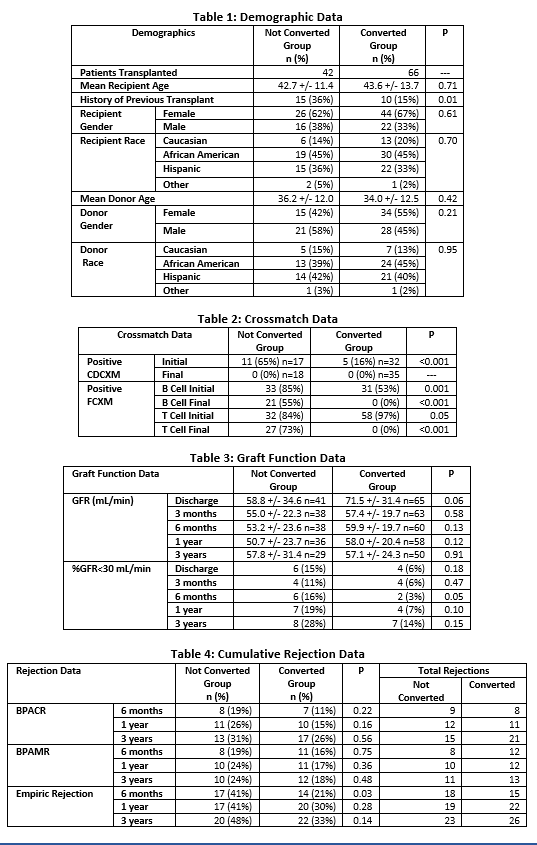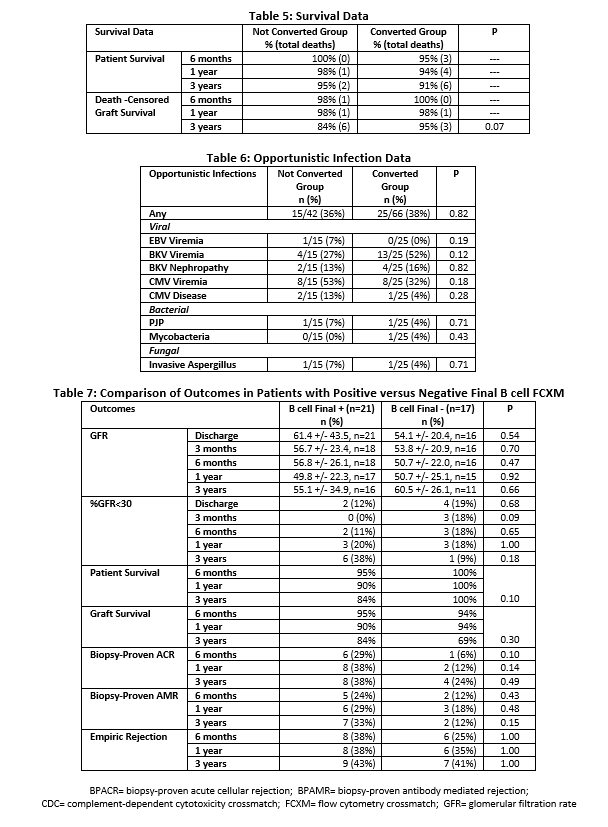Three Year Outcomes Following Positive Crossmatch Renal Transplantation Despite Failure to Convert to Negative Flow Crossmatch After Desensitization.
1Pharmacy, University of Illinois Hospital &
Health Sciences System, Chicago
2Surgery, University of Illinois Hospital &
Health Sciences System, Chicago
3Medicine, Loyola University Health System, Maywood
Meeting: 2017 American Transplant Congress
Abstract number: A53
Keywords: Flowcytometry crossmatching, Highly-sensitized, Outcome
Session Information
Session Name: Poster Session A: Clinical Science: Kidney Immunosuppression: Desensitization
Session Type: Poster Session
Date: Saturday, April 29, 2017
Session Time: 5:30pm-7:30pm
 Presentation Time: 5:30pm-7:30pm
Presentation Time: 5:30pm-7:30pm
Location: Hall D1
Purpose: To determine outcomes of positive crossmatch (PXM) renal transplant recipients that failed to convert to a negative flow cytometry crossmatch (FCXM) despite desensitization. Methods: A search of UI Health transplant records was performed to identify patients that underwent desensitization before PXM renal transplant between 1/1/00 and 11/1/11. Patients receiving a transplant despite failure to convert to negative FCXM were identified for analysis (not converted group). Patients who converted to negative FCXM after desensitization comprised the control arm. The primary endpoint is mean eGFR. Secondary outcome measures include % eGFR < 30mL/min, patient & graft survival, episodes of rejection, and all measures were assessed at 6 months, 1 year, & 3 years post-transplant. Results:108 patients were desensitized before PXM transplant, (not converted group=42; converted group=66). 
 Conclusions: Mean eGFR was comparable between groups at all time points, and 3-year eGFR was 57.8 mL/min vs. 57.1 mL/min, p = 0.91. Patients with eGFR < 30mL/min at 3 years did not differ significantly (28% vs. 14%, p = 0.15). Biopsy-proven rejection rates were numerically higher within the not converted group for each type of rejection and time point, but the values did not differ significantly. Three-year BPAMR was 24% in the not converted group vs. 18% (p = 0.48). Opportunistic infections rates were comparable. Patient survival (95% vs. 91%) and death-censored allograft survival (84% vs. 95%, p=0.07) were similar between arms at 3 years post-transplant.
Conclusions: Mean eGFR was comparable between groups at all time points, and 3-year eGFR was 57.8 mL/min vs. 57.1 mL/min, p = 0.91. Patients with eGFR < 30mL/min at 3 years did not differ significantly (28% vs. 14%, p = 0.15). Biopsy-proven rejection rates were numerically higher within the not converted group for each type of rejection and time point, but the values did not differ significantly. Three-year BPAMR was 24% in the not converted group vs. 18% (p = 0.48). Opportunistic infections rates were comparable. Patient survival (95% vs. 91%) and death-censored allograft survival (84% vs. 95%, p=0.07) were similar between arms at 3 years post-transplant.
CITATION INFORMATION: Patel S, Benken J, Akkina S, West-Thielke P, Thielke J, Campara M, Oberholzer J, Benedetti E. Three Year Outcomes Following Positive Crossmatch Renal Transplantation Despite Failure to Convert to Negative Flow Crossmatch After Desensitization. Am J Transplant. 2017;17 (suppl 3).
To cite this abstract in AMA style:
Patel S, Benken J, Akkina S, West-Thielke P, Thielke J, Campara M, Oberholzer J, Benedetti E. Three Year Outcomes Following Positive Crossmatch Renal Transplantation Despite Failure to Convert to Negative Flow Crossmatch After Desensitization. [abstract]. Am J Transplant. 2017; 17 (suppl 3). https://atcmeetingabstracts.com/abstract/three-year-outcomes-following-positive-crossmatch-renal-transplantation-despite-failure-to-convert-to-negative-flow-crossmatch-after-desensitization/. Accessed December 25, 2025.« Back to 2017 American Transplant Congress
